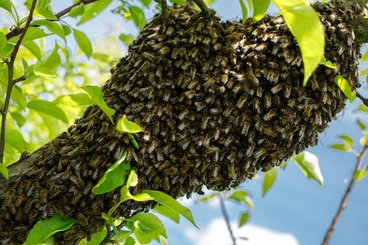Did a swarm of honey bees just land in a tree near your home?
Do you have a colony of honey bees living behind the siding of your home?
Do you have a wasp nest in the ground, behind the siding or hanging on the eaves of your house?
Many people confuse yellow jacket wasps, hornet wasps, and honey bees. So that you can get the help you need, please consult this link to correctly identify whether you have found bees, yellow jackets, wasps, or hornet wasps on your property.
Wasps
The University of Minnesota Bee Lab does not remove wasp nests from structures. Our advice is: if they are not bothering you, enjoy them, or at least ignore them, for our short summer season; the pesky wasps will be dead after two hard frosts.
Please read Bothered by Bees or Wasps? (.pdf) for more information and photos.
Honey bees and Swarms

Local hobby beekeeping associations are equipped to collect swarms from your yard. For information and photos on what a swarm of honey bees looks like: Swarms (by the Minnesota Hobby Beekeepers Association)
Honey bees and bees in general are not aggressive by nature and only seek pollen and nectar sources. Honey or bumble bees only sting when protecting their hive or nest or themselves from a threat. You may be seeing a swarm of honey bees looking for a new home. These bees will gather on a tree limb or concealed space until scouts find a new home, usually within 12 to 36 hours. During swarming, the bees are especially gentle, as they are not protecting any home.
If honey bees have taken up residence in your home, there are professionals that can remove them, but often it involves some major destruction and reconstruction of your home or building. For Twin Cities area removal of honey bees from structures, see this list of Minnesota beekeepers: Removal of Swarms and Bees from Structures
Bumble bees
Bumble bees are usually only defensive (likely to sting) when their nest is disturbed. People can usually live peacefully with a nearby bumble bee colony by simply placing some garden fencing or chicken wire around the area of the nest entrance. This prevents people from accidentally getting too close to the nest, but does not interfere with the bees. Colonies are annual. If you do not discover the nest until August, it will not be long before the nest is done.
Bumble bees nests that are moved have a high failure rate. We do not recommend moving a nest unless there is no other choice. Even when there is no other choice, be aware that we have a federally protected bumble bee species in MN, the rusty-patched bumble bee. It is against the law to intentionally destroy a rusty patched bumble bee nest. Please verify what kind of bumble bee you have before moving or destroying a nest. See Bee ID guide here. You can send photos of bumble bees to [email protected]
If you are regularly getting bumble bees in your basement, it is likely that they are nesting in your siding somewhere and have found a way into your house. If you can find the hole they are using on the inside of your house, you can plug it at any time. If you can find the hole in your siding, you can plug it after the first frost or two without causing damage to the hive.
Ground nesting bees
Some species of solitary bees can form many nests close together. You may see dozens of bees flying in an area. These bees are non-aggressive and many of them are males (which have no sting), meaning that they you are highly unlikely to be stung even when close to the nest. Please enjoy the brief show they provide. The adults are typically only active for a few weeks. The rest of the year the young will develop under ground. Please do not disturb the soil or apply pesticides in the area even after the bees are no longer active.
In April and May, if you see a large number of bees near the ground, they are likely to be solitary, ground nesting bees, such as miner bees (Andrena) or plasterer bees (Colletes). We are hoping to learn more about these bees.
There are also social, sweat bees that form larger nests with many bees together in one nest. These bees are also non-aggressive and should not cause problems. These bees are usually active from April through September. Some may overwinter in the nest, but they are unlikely to use the same nesting spot again next year.
